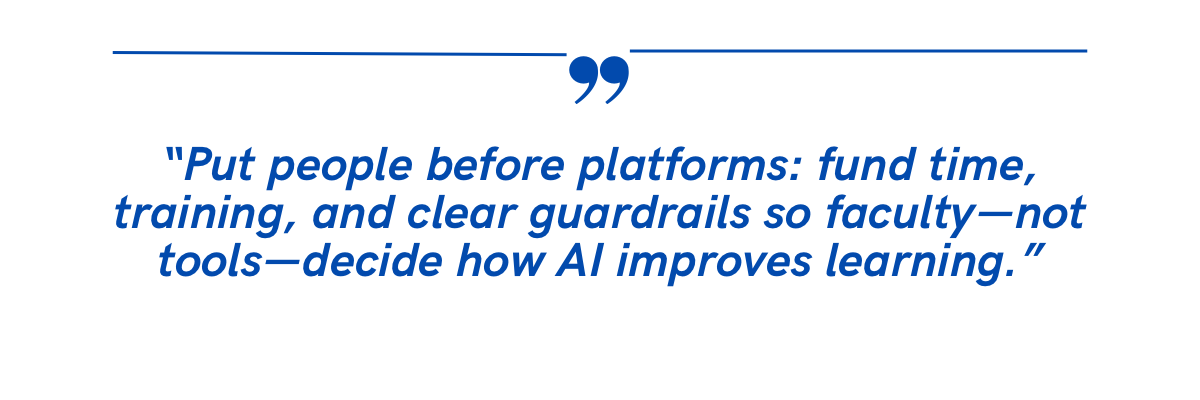If last year was about trying chatbots, this week is about wiring AI into the systems faculty and students already use. Federal infrastructure moved from idea to implementation, campuses piloted AI at full undergraduate scale, and vendors collapsed sprawling add-ons into cleaner, governable offerings.
The throughline is platform-aligned faculty capacity: policy signals (UNESCO, Jisc), institution-level pilots (Duke), and consolidated tools (Google AI Pro) only translate into better learning when departments pair them with assessment redesign, syllabus-level guidance, and credible professional development (think Penn State’s endorsement and Illinois State’s workshop series). What follows spotlights where that shift is already happening—and where it still needs muscle from faculty leadership.


NSF Flips the Switch From Pilot to Platform
Summary
What if AI research capacity worked like a public utility? The National Science Foundation’s new solicitation to establish the NAIRR Operations Center moves the U.S. from a proof-of-concept to a national, shared service for compute, models, and data—built for researchers and classrooms alike
(National Science Foundation [NSF], 2025).
The Details
- Solicitation released Sept. 3, 2025 to select an operator for day-to-day NAIRR services.
- Formalizes governance, security, and service tiers; scales beyond the pilot’s ad-hoc access.
- Envisions equitable on-ramps for a wide range of institutions—not just well-resourced labs.
- Positions campuses to align methods courses, capstones, and multi-institution projects with policy-compliant infrastructure.
Why it Matters
When compute and curated data stop being the bottleneck, pedagogy and research design can lead. NAIRR-OC is a lever for leveling access, accelerating faculty scholarship, and letting instructors teach modern AI methods without asking students to bring their own GPU.
A Whole Campus on AI: Duke’s Bold A/B Test
Summary
What happens when an entire undergraduate body gets sanctioned, supported AI access? Duke’s Provost-led pilot gives every undergrad ChatGPT-4o plus “DukeGPT,” letting faculty test learning gains, integrity measures, and assessment redesigns at real scale
(Associated Press, 2025).
The Details
- Launched June 2, 2025; findings due after the fall term.
- Assessment shifts include more oral exams, in-class work, and explicit disclosure norms.
- Faculty reactions span cautious endorsement to concern about overreliance; student feedback highlights structure and clarity alongside dependency risks.
- Secure, institution-managed access creates a clean test bed for policy and course design.
Why it Matters
This isn’t another lab pilot—it’s governance in action. By pairing access with redesigned assessment and faculty judgment, Duke is generating evidence other campuses can use to set syllabus language, writing expectations, and classroom norms without guesswork.

Policy & Governance
-
UNESCO’s AI Reality Check: High Use, Patchy Policy
Adoption is sprinting ahead of governance—nine in ten are using AI, yet many campuses are still writing the rules (UNESCO survey).
-
Jisc to Universities: Build Skills, Not Bans
Students are using AI anyway; the smart move is explicit skill-building tied to integrity and employability (Jisc report).

Programs, Research & Infrastructure
-
Google AI Pro for Education: One SKU to Rule Your Pilots
Cleaner licensing and built-in NotebookLM/Gemini make department-level trials easier to launch—and easier to govern (Google Workspace Updates, 2025.
-
Penn State’s AI-Enhanced Pedagogy: PD With Proof
A Provost-endorsed pathway turns workshops into recognized evidence of AI-ready teaching practice (Penn State News, 2025).
-
Illinois State’s 10-Workshop Sprint: From Hype to Hands-On
A campus-wide series walks faculty from tools to assignment design, feedback, and research workflows—grounded in inclusive teaching (Illinois State University News, 2025).
-
MIT’s “FlowER”: No More Alchemy in Reaction Prediction
A physics-aware generative model enforces conservation laws—great fodder for lab courses and graduate methods (Chandler, 2025).
-
Synthetic Data, Sanity Check
Fast and privacy-friendly—but only if you validate against the real world; a crisp primer for labs and IRBs (Zewe, 2025).

Other
-
Columbia’s “Sway”: AI That Coaches Civil Debate
An experiment in AI-guided dialogue aims to cool hot-button conversations and protect campus discourse (Hern, 2025).

Do It Now Checklist
Betting on platform-aligned faculty capacity
Put faculty at the center: co-design rubrics, exemplars, and integrity language that make AI transparent and teachable. Recognize this work in workload and evaluation, and measure outcomes (thinking, writing, persistence) rather than tool usage. Betting on platform-aligned faculty capacity is betting on accountable adoption that improves teaching and scholarship.
With Inspiration Moments, we share motivational nuggets to empower you to make meaningful choices for a more fulfilling future. This week, betting on platform-aligned faculty capacity means letting people, not products, drive change: invest in time, training, and clear guardrails so the tech serves learning. Stay mindful, stay focused, and remember that every great change starts with a single step. So, keep thriving, understanding that “Life happens for you, not to you, to live your purpose.” Until next time.
Respectfully,
Lynn “Coach” Austin
References
All sources are hyperlinked in-text for immediate access to original publications.

